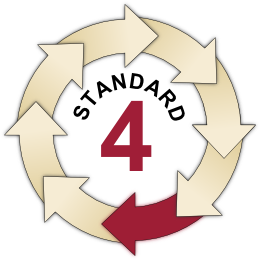Instructional materials (also known as instructional media or course content) can be the most fun and creative aspect of developing an online course.
 Instructional materials are items such as books, journal articles and other print material, digital video and audio, computer software, simulations, and other digital content that are used as part of the instructional process. While the format of instructional materials has evolved and will continue to change, the purpose remains the same: Instructional materials and media remain the primary tool that instructors use to convey concepts, topics, and information to scaffold student learning in conjunction with well-aligned learning objectives, activities, and assessments.
Instructional materials are items such as books, journal articles and other print material, digital video and audio, computer software, simulations, and other digital content that are used as part of the instructional process. While the format of instructional materials has evolved and will continue to change, the purpose remains the same: Instructional materials and media remain the primary tool that instructors use to convey concepts, topics, and information to scaffold student learning in conjunction with well-aligned learning objectives, activities, and assessments.
This presents the fundamental challenge: choosing from the many types of instructional materials—while maintaining alignment with your learning objectives and also weighing issues of copyright, fair use, and accessibility. Since it is so easy to link to resources and materials online, it is also easy to select content that may not actually be needed to meet the course learning objectives—leading to an overwhelming amount of course materials.
Also, making decisions about finding or developing content can be a very time-consuming part of any course development process, particularly with online courses. This is because it is important to select just the right activities and assignments to align with your course learning objectives.
Consider these questions as you select instructional materials for your course:
- Is the scope and coverage appropriate?
- What will learners read/explore?
- What will learners view/hear?
- What could learners experience/create?
- Will you find or create this material?
- Do materials and media support and align with the stated learning objectives?
- Is there sufficient interactivity and engagement?
In the early days of online teaching, it was initially thought that building an online course simply involved selecting a good textbook and/or writing out the lectures and posting them within the online class. As online learning has evolved, it has become clear that this approach is not sufficient to engage online learners and allow them to meet the learning objectives or competencies.
Instead, it is recommended to choose appropriate instructional materials from a wide variety of options. For example, instructors may:
-
Adopt a standard textbook or use an e-textbook. (Read about how to remove barriers to using e-textbooks.)
-
Provide a list of resources from the campus' online library.
-
Select an open educational resource.
-
Have learners create their own materials.
There are so many choices of content and resources available. Therefore, it may be confusing or overwhelming…hence, the importance of using the stated learning objectives or competencies as the basis for selecting appropriate instructional materials.
General Standard 4: Instructional Materials

The Instructional Materials standard prompts instructors to consider the currency and variety of the instructional materials, appropriately cite them, and ensure that learners know the purpose and how the materials are to be used with the learning activities.
The following Quality Matters™ standards provide a good checklist for instructional materials:
4.1 The instructional materials contribute to the achievement of the stated learning objectives or competencies.
4.2 The relationship between the use of instructional materials in the course and completing learning activities is clearly explained.
4.3 The course models the academic integrity expected of learners by providing both source references and permissions for use of instructional materials.
4.4 The instructional materials represent up-to-date theory and practice in the discipline.
4.5 A variety of instructional materials is used in the course.
Full Annotated Rubric: Quality Matters General Standard 4: Instructional Materials
Source: Quality Matters™ Rubric Standards with Assigned Point Values
Reprinted with permission. Copyright © 2018 by MarylandOnline, Inc. All rights reserved.